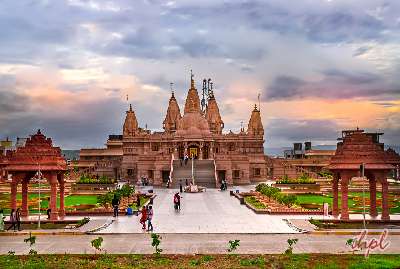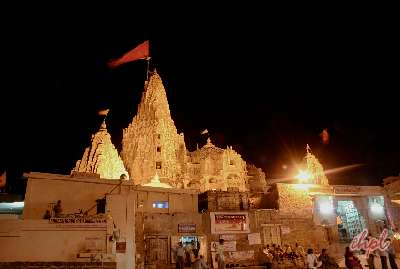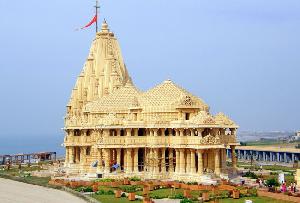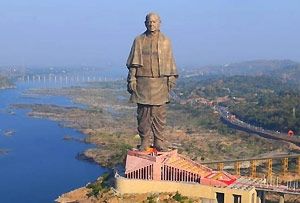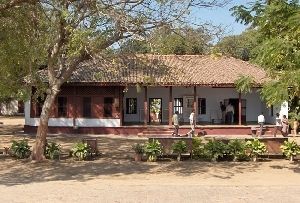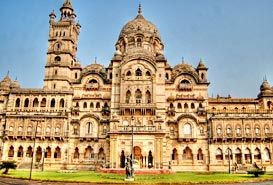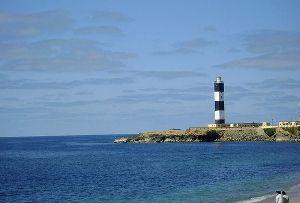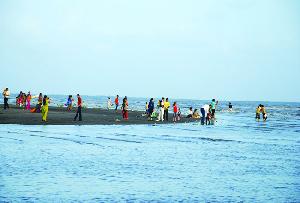Champaner-Pavagadh Archeological Park in Champaner is a UNESCO World Heritage Site. It represents a perfect blend of Hindu-Islamic architecture, mainly in the Great Mosque (Jami Masjid), a replica of later mosque architecture in India. This special style comes from the noteworthy period of regional sultanates.
This site is a magnificent historical confluence, displaying 1,200 years of history and culture. It is believed to bear evidence of the Indian Puranic ages, the Rajput saga, the glory of the supremacy of the Marathas, the Islamic influences, and finally, bears testimony to the British occupation within its remains.
The Champaner-Pavagadh Archaeological Park is an ideal example of a short-lived capital, making the best use of its setting, topography, and natural features. However, it is quite exposed due to abandonment, forest takeover, and modern life. Besides, the archaeological park is a place of worship and continuous pilgrimage for Hindu believers.
Champaner-Pavagadh Archeological Park features several archaeological and historical sites along with living cultural heritage structures that are yet to be excavated. The site comprises a hill fortress of an early Hindu capital from the 16th century, which has palaces, temples, residential precincts, agricultural structures, and water installations.
The structures in the park belong to periods ranging from the 8th to 14th centuries. Thousands of pilgrims visit the auspicious Kali Mata Temple atop the Pavagadh Hill to pay their homage to the Goddess. The site is immensely imperative for studying pre-Mughal Islamic history, as it is the only complete city from that time that hasn’t undergone any transformations later.
Timings: 8.30 am to 5 pm, open all days of the week
Entry Fees at Champaner-Pavagadh Archeological Park
Indian Visitors: Total Rs.40/-(Cash),Rs.35/-(Online) per person
Citizen of SAARC and BIMSTEC countries:Total Rs.40/-(Cash),Rs.35/-(Online) per person
Other Foreign Visitors: Total Rs.600/-(Cash),Rs.550/-(Online) per person
Ticket with Facilities: Rs.850/-(Cash),Rs.800/-(Online)
History of Champaner-Pavagadh Archeological Park
Around 1300, the Chauhan Rajputs made Pavagadh their capital, but in 1484, it was taken over by the Gujarat Sultan Mahmud Begada after a siege of 20 months. As the Rajputs were defeated, they performed a ritual mass suicide called Jauhar. After taking control of Pavagadh, the Sultan made Champaner the new capital. But when Mughal Emperor Humayun came into the picture in 1535, the rule of the Sultan was cut short. Humayun captured the capital, and the capital shifted to Ahmedabad, leaving Champaner in ruin.
Attraction at Champaner-Pavagadh Archeological Park
On visiting Champaner-Pavagadh Archeological Park, you shall explore the ancient Hindu palace and temple architectural styles. Also, witness the special water retaining installations of that time that were used to battle water scarcity. Further, there are religious, military, and agricultural structures in the park that suit the 16th-century capital of the region constructed by Mehmud Begda.
Here are the top attractions at Champaner-Pavagadh Archeological Park
Nagina Masjid
One of the prominent structures in the archeological park is Nagina Masjid. It is built on a raised platform with ample open space. The mosque’s entrance has minaters on either side, carved beautifully with floral designs. Moreover, as you visit the main prayer hall, witness three massive domes over the hall with exquisite columns and windows. There are a few brick structures, a well, and a cenotaph.
Kevada Masjid
Transferring you back to the former days, Kevada Masjid is built on a rectangular platform with a double-storey prayer hall. It has two minarets on the side of the entrance, carved exquisitely with floral and geometrical patterns. The windows of the Kevada Masjid have a pillared balcony. Initially, the mosque had three domes, but the largest one collapsed. Besides, there is a well, ruined brick structures, and a tank in the complex.
The Jami Masjid
Also called Jama Masjid of Champaner, the Jami Masjid is approx. 150 feet east of the city walls. It is a gigantic structure that dates back to the 15th century. Not only this, but it is one of India’s finest mosques. There are two imposing minarets like the other mosques, along with seven prayer niches called mehrabs, in the back wall of the main prayer hall. Out of the mosque’s three entrances, the eastern one is known for its carving and Jaali work.
Citadel
Constructed by Mahmud Begada, the Citadel at the park has walls running north to south, with several gates and bastions. All the Citadel’s gates are two-storeyed. They also have rooms for watchkeepers. Among all the gates, only four are in good condition. The east gate, called Halol, and the south gate, called Godhra, are massive rectangular gates and must-see attractions in Champaner-Pavagadh Archeological Park.
Best time to Visit Champaner-Pavagadh Archeological Park
Winter months, i.e., October to February, are the best to visit Champaner-Pavagadh Archeological Park. The weather is cool and pleasant, which makes your beach day more enjoyable.
How to Reach Champaner-Pavagadh Archeological Park
- By Air – Vadodara Airport is the nearest to Champaner, located about 43 km away. A 1-hour drive from the airport will take you to the archeological park. Taxis are available from the airport to Champaner.
- By Train – Champaner Railway Station is approx. 21 km from Champaner town and takes about 30-40 minutes. The station is well-connected with cities in Gujarat and others in India. Taxis run between the station and the town, so reaching Champaner will be easy.
- By Road – Buses ply from cities in Gujarat like Ahmedabad, Vadodara, and more to Champaner regularly. You can also drive your vehicle as the roads are smooth and well-maintained.
For more details about the tour to Champaner-Pavagadh Archeological Park, contact Indian Holiday. Plan a Gujarat travel package covering your meals, stays, transfers, and sightseeing tours. Customization is available as per your preferences.



